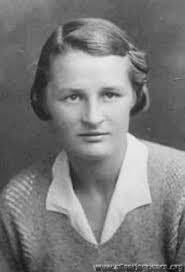Margaret Cunnison (29 May 1914 – 4 January 2004)[1] was a Scottish aviator and the first Scottish woman flying instructor. She was one of the first women to join the Air Transport Auxiliary.
Margaret Cunnison | |
|---|---|
 | |
| Born | 29 May 1914 Haddington |
| Died | 4 January 2004 (aged 89) Haddington |
| Nationality | British |
| Other names | Margaret Ebbage |
| Occupation | pilot |
Life
editMargaret Cunnison was born in Haddington in 1914. Her family was originally from Blairgowrie, in Perthshire, but they were living in Milngavie. Her father, James Cunnison was a lecturer in political economy at the University of Glasgow.[2] Cunnison attended Laurel Bank School.
In 1933 Cunnison entered a competition to win an "air scholarship" with the Evening News and won lessons with the Scottish Flying Club.[3] She got her A Licence in Scotland then travelled to Lympne, Kent, to get her B licence, and gained the second Scottish woman's commercial pilot's licence.
She was already an instructor before the war and worked as an instructor with the Strathtay Aero Club.[4]
Air Transport Auxiliary
editCunnison joined the Air Transport Auxiliary (ATA) with the other initial 7 women in 1940.[4] Together with Joan Hughes, Mona Friedlander, Rosemary Rees, Marion Wilberforce, Margaret Fairweather, Gabrielle Patterson and Winifred Crossley Fair they were known as the First Eight, and appointed by the Commandant of the ATA's women's section, Pauline Gower.[5] Cunnison was the leading instructor at Hatfield Aerodrome responsible for evaluating and training the new pilots.[2]
She signed off on the American women pilots at Luton. As a result of her role, Cunnison mostly flew light aircraft.
She left the ATA to get married in 1943 to Geoffrey Ebbage, an ophthalmic surgeon with the RAMC.[4] They lived in London and had a son. Cunnison died in Haddington in 2004.[5][6][7][8][9][10][11][12][13]
Legacy
editA bus company in Hatfield named its eight buses after the "first eight" of the Tiger Moth pilots in the ATA, including Cunnison.[14]
In 2008, four years after her death, the fifteen surviving women members of the ATA (and 100 surviving male pilots) were given a special award by the Prime Minister Gordon Brown.[15]
References
edit- ^ A Fleeting Peace website, Pioneering Women: Margaret Macdonald Cunnison
- ^ a b The Scotsman website, Obituary, dated February 2, 2004
- ^ Scottish Aero Club website, A Brief History
- ^ a b c ATA Ferry Pilots website, Margaret MacDonald Cunnison
- ^ a b Poad, Richard (2020-01-14). "ATA's first 8 women pilots". Air Transport Auxiliary. Retrieved 2020-03-04.
- ^ McDonough, Yona Zeldis (2012-04-30). "The Women's RAF". Air & Space Magazine. Retrieved 2020-03-04.
- ^ "ATA First Eight". British Air Transport Auxiliary (in German). Retrieved 2020-03-04.
- ^ "The original Scottish Flying Club". Strathaven Airfield. 1940-11-01. Retrieved 2020-03-04.
- ^ Wheeler, J. (2018). The Hurricane Girls: The inspirational true story of the women who dared to fly. Penguin Books Limited. p. 73. ISBN 978-0-241-35464-3. Retrieved 2020-03-04.
- ^ Walker, D.B. (2008). Spreading My Wings: One of Britain's Top Women Pilots Tells Her Remarkable Story from Pre-War Flying to Breaking the Sound Barrier. Grub Street Publishing. p. 185. ISBN 978-1-908117-65-6. Retrieved 2020-03-04.
- ^ David, S.; Moule, I.A. (2006). Women in Space - Following Valentina. Springer Praxis Books. Springer London. p. 32. ISBN 978-1-84628-078-8. Retrieved 2020-03-04.
- ^ Curtis, L. (2004). Lettice Curtis: Her Autobiography. Red Kite. p. 83. ISBN 978-0-9546201-1-0. Retrieved 2020-03-04.
- ^ "Margaret Ebbage". Google. 2004-02-02. Retrieved 2020-03-04.
- ^ "Inspirational ATA Female Pilots Honoured". Women in Transport. Retrieved 2020-03-01.
- ^ "Britain's FEMALE Spitfire pilots to receive badge of courage at last". Evening Standard. 2008-02-21. Retrieved 2020-03-01.